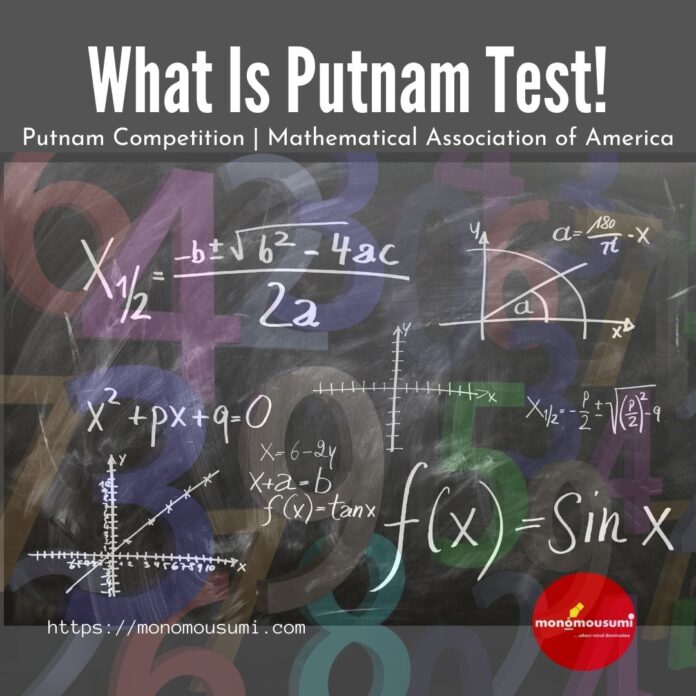“Without mathematics, there’s nothing you can do. Everything around you is mathematics. Everything around you is numbers.”
— Shakuntala Devi
Math may seem catastrophic to many individuals ranging from small kids to grown-ups. But it is not skeptical to claim that many prodigies including Paul Erdös (1913-1996), Srinivasa Ramanujan (1887-1920), Shakuntala Devi (1929-2013), Archimedes (288 BC-212 BC) and many more profoundly established their names in the field of mathematics. It endorses the fact that math is fascinating too and many aspirants hunt for exciting math exams. One such engrossing exam is The William Lowell Putnam Competition or Putnam Test.
The competition was founded in 1927 by Elizabeth Lowell Putnam in the memory of William Lowell Putnam, her husband and a proponent of intercollegiate intellectual competition. After 1938, it is conducted annually by the Mathematical Association of America (MAA)—It is a professional society that focuses on mathematics accessible at the undergraduate level, founded in 1915. The competition is open for undergraduate college students enrolled at institutions of higher education in the United States of America (USA) and Canada (irrespective of their nationalities). It is widely acknowledged as the most distinguished and strenuous university level math competition in the world. The difficulty level of the Putnam test is rated highest among many potential exams. Even its median score is 0 (out of 120) despite being endeavored by many eminent mathematicians.
The winners of the Putnam competition are awarded scholarships and cash prizes ranging from $250 to $2500 for students at the top and $5000 to $25000 for top schools. Additionally, the top five maximum scoring contestants are designated as Putnam fellows. A scholarship of $1200 and tuition at Harvard University is awarded to them. It can also be considered as a Putnam Fellow Prize fellowship. Top hundred individual scorers successfully bring up their names in American Mathematical Monthly— a magazine formulated by MAA on monthly basis.
Registration for the competition is generally handled by student’s respective institutions, especially the mathematics department or its equivalent. Another important registration rules, detachments, and details can be found at the MAA’s official website that i.e. www.maa.org . The notifications regarding conduction, announcement, and result are regularly updated on the official website. Undergraduate students must participate in their college or university in which they are enrolled. Any college or university in US for Canada wishes to extend the benefit of the competition to their excellent prodigies can directly contact MAA. They just need to nominate a regular faculty member to serve as a local supervisor of the competition. On the other hand, those who already hold a bachelor’s degree are ineligible for the competition as its ultimate motive is to promote youth in mathematics. No individual can participate in the competition more than four times.
Putnam competition takes place annually on the first Saturday of December by the respective schools, colleges, and universities. While analyzing the format and overall structure of the exam one should not forget that the competition consists of two- 3-hour sessions, one in the morning and one in the afternoon. During each session, participants are entrusted to solve and work individually on 6 challenging mathematical problems. The procedural aspect of the exam is individualistic but competition has a team aspect as well. Institutions are ranked according to the sum of the scores of their three highest-scoring participants as prizes are awarded to the high scorers and to the department of mathematics of five institutions the sum of whose top three scores is highest. The format of the paper is not very comprehensive in contrast to the level of the questions asked in the paper. The twelve questions asked during two sessions are very eclectic and deals with a wide range of advance mathematical problems including concepts from Group theory, Ring theory, Graph theory, Number theory, Combinatorics — branch of mathematics studying the enumeration, Combination, and Permutation of sets of elements, Algebra, Topology, Complex numbers, and Probability. Each question of the 12 consists of 10 points. A complete solution owes 10 points, 9 points for a nearly complete solution, and 1 point for the beginning of the solution. In earlier years each of the questions was worth one point each and no partial credit score was granted. But as the difficulty level of the competition is breathtaking, the concept of partial scoring was introduced. Median score usually varies from 0 to 1 out of 120. Taking stats of MAA into consideration, until 2010 only four students were able to achieve a perfect score of 120. On Indian counterpart, Shyam Narayan, an Indo-American student won the competition and in addition to winning, he was enlisted among five Putnam fellows in the 79th year of the competition. Then in 2019 Amit Shah, a student of Massachusetts Institute of Technology (MIT), US won the competition and simultaneously Putnam fellowship.
Syllabus of Putnam competition is very overarching and comprises elaborated topics like elementary concepts from linear algebra, modern algebra, number theory, sets theory, and complex numbers. Problems and solutions of previous year papers are available on the Putnam competition archive page of the MAA’s website in the form of PDF. Some books are available in the US and Canada markets that can help students prepare for this exam. It includes The William Lowell Mathematical Competition Problems and Solution Edition 1(1938-1964) by A.M Gleason, R.E Greenwood and L.M Kelly, Edition 2 (1965-1984) by Gerald L Alexanderson, Leonard F Klosinski and Loren C Larson and Edition 3 (1985-2000) by Kiran S Kedalya, Bjorn Poonen, and Ravi Vakil.
The preparation strategy of the Putnam exam is self-oriented or we can say it is the innate talent of the individual. The plan of action requires a minimum of one year to analyze the mechanism of the exam. One key mantra to become a Putnam fellow is to practice math and mathematical problems dealing with topics of Putnam exam’s syllabus. MAA assembles recent examples on their website which need to be solved on daily basis. High difficulty proof-based question solving is necessary as the Putnam exam scrutinize mathematical maturity. MIT provides courses and sessions on solving challenging mathematical problems and prepares individuals for Putnam competition with no prerequisites excluding the compulsory condition of being an undergraduate. After the session problem sets are given. Students are encouraged to solve them with multiple approaches. These sessions are very useful for all aspirants.
The solutions are scrutinized by the mathematicians, scholars, and professors across the globe selected by MAA. After that result is mailed on respective email addresses by the participants. The announcement of winner PDF containing names of top 500 contestants and the names of the top 10 teams are mailed to all contestants and supervisors. Results are also updated on MAA’s official website and other electronic media like Twitter, Instagram, and Facebook. If students have queries about checking and evaluation procedures they can mail at putnam@maa.org.
Many Putnam fellows in the future become more distinguished researchers in mathematics and other fields. On exemplary count consider John Willard Milnor ( born Feb 20, 1931), is an American mathematician known for his contribution in differential topology, k-theory, and dynamical systems was a Putnam Fellow. Other renowned Putnam fellows are Lewis Mumford( born 19 October 1895) and Daniel Quillen( born 22 June 1940). Some Putnam fellows had become Nobel laureates viz. Richard Philips Feynman and Kenneth G Wilson, both were American theoretical physicists. There is no wonder that the Putnam test is a magnificent opportunity for individuals who are in love with mathematics and want to attain a good portfolio in the field of mathematics.
The 81st Putnam competition that was going to be organized in 2020 is postponed until Feb 2021 due to coronavirus. Due to this pandemic, most of the students in the US and Canada are unable to return their respective campuses. Nonetheless, it provides a great opportunity for all undergraduates residing in the US and Canada, to acknowledge their abnormal mathematical talent. As if the normality fails to appear after the pandemic gets over the test will not be postponed. The competition on the date will proceed in an unofficial mode with no proctors, no prizes, no awards but with solution paper submitted for grading by participants themselves. Consequently, scores will be reported back privately to the individual participants. It can be noted that one should prepare for this exam with great efforts and hard work. As per overall conclusion, the Putnam test is very essential for math wanderers or those who find numbers as elusive and magical. Individuals should grab the opportunity and become a successful Putnam fellow.
By Simran Bhati, 19 years, Indore
















